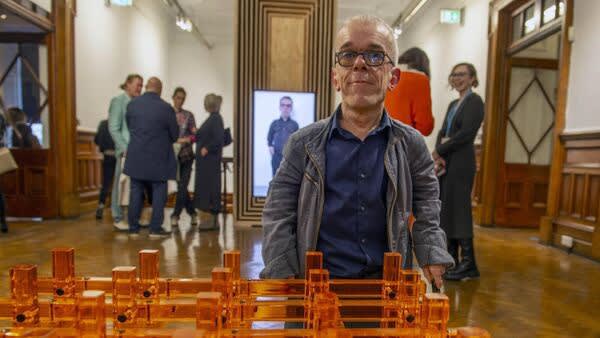When hanging his show at the Crawford, artist Corban Walker didn't take a conventional approach. The Dublin-born artist is four feet tall, and decided to hang the works as low as possible.
“I brought them down to my eye level, which may seem low for other people, but it actually relates to the other variable heights within the gallery; the door handles, the corners of the walls and all that,” he says.
Walker’s stature has informed many of his most memorable artworks, from Please Be Seated – the huge wooden chair he showed at his degree show at NCAD in 1989 - to the work in his current exhibition that confronts the viewer at the top of the Crawford’s grand staircase, a video called TV Man, “which is basically a life sized portrait of myself,” playing on a loop on a video monitor contained in a wooden crate.
Walker’s new exhibition, As Far As I Can See, re-visits his relationship with the Crawford; in 2000, when the gallery’s new wing was opened, it included Walker’s installation of fibre lighting on the stairwell, a work that remains in situ 22 years later.
“That was the first public art commission I’d done that was a direct response to the building itself,” says Walker, who recently returned to settle in Ireland after twelve years in New York. “I chose that area of the wing to try and concentrate on movement and how people articulate space, how people get from one level to the next. This is something I can relate to very clearly on a day to day basis, in that I’m always aware of the built environment, because it’s not designed for my capacity. I have to adapt to it.”
There are two strands to As Far As I Can See: the first is Walker’s curation of work drawn from the Crawford Collection; the second a selection of his own new and recent work.
“ I was really interested in the idea of having free rein over what I could choose from the collection, but also in how I could bring the building back to its original state, and to clear all the interruptions within it,” he says.
To this end, Walker supervised the repainting - in more uniform colours - of the gallery walls, and the removal of a number of works that had become synonymous with the space itself. These included a number of paintings hanging each side of the grand staircase, “these hideous portraits of the occupiers of the country, the Prince of Wales on one side and the Lord Mayor on the other,” and the Gibson Vitrine, a glass cabinet of curiosities, “which in lots of ways was obstructing the flow and the view around the galleries.”
When it came to selecting work from the Crawford Collection, Walker found himself drawn to artists he’d known since early childhood through his late parents, the architect Robin and the author, critic and curator Dorothy Walker. “People - like Cecil King, Patrick Scott, Louis le Brocquy, Anne Madden and Kathy Prendergast - who I remember being around the house, attending committee meetings, or having a cup of tea and a chat. But also, these were people whose work had an impact on me, in terms of how I would learn to appreciate and explore the visual arts. So, drawing on the work of such a diverse group of artists to make a cohesive show was an amazing opportunity and a very enjoyable process.”
As for hanging the pieces so low, Walker says it changes the whole perspective of viewing the work. “There’s a nice balance, a kind of spatial latitude between the viewer and the work. When you hang the work up high, it’s kind of detached. By hanging it low, you’re absorbing it more, and you do become part of it more. That’s what I’m trying to do with my work, I’m trying to give the viewer a sense of themselves. They become part of the work, rather than just viewing it.”
Walker put one of his own works – a sculpture he calls Stanchions – in the same gallery. “It’s a piece I made a few years ago on a residency in France. And I thought this was a perfect space to show it in again; it’s a grand room, and I’ve placed the pieces at particular points, so that it adds a sense of circulation, and you walk through gracefully.”
He placed his other sculptures on the landing and in the Gibson Galleries. “I wanted to introduce a number of works I made in New York to an Irish audience. There’s one piece called Cubed, Drawn, Halved, which is an acrylic cube that is basically my height divided in two, sitting on a mirrored plinth, so it’s doubling itself into this well of reflected area that both does and does not exist.
“And then, in the Gibson Galleries, the scale is altered again, by the very dense acrylic pieces on the floor. One of these is a glass stack, which uses regular window glass, in a heavy gauge that’s cut and mitred into these box formations and stacked. That has its own quality of refracting light and defining scale and giving you the illusion of what you think is there and is not there.”
Walker has lived in Cork since returning from New York in 2019, and plans on staying. He has been working at the National Sculpture Factory on Albert Road, preparing for a number of shows. “There’s a better lifestyle here than there is in Dublin,” he says.


